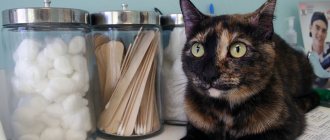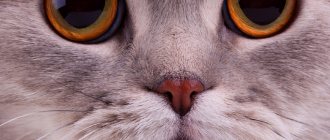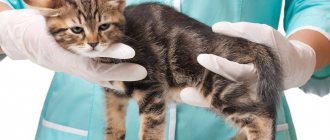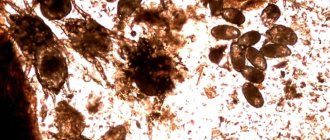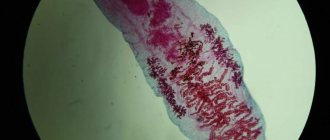Causes
Among the reasons that lead to a cat going bald at the tail are::
- various skin diseases. In such cases, the cat feels severe itching, which it cannot tolerate and scratches, thus combing out pieces of fur. Often large foci of the disease appear and are localized precisely on the tail, at its base. Here it is worth using different shampoos, drops and ointments to eliminate the problem and return the cat to a normal rhythm of life;
- oily seborrhea. These are disturbances in the functioning of the glands that produce fat necessary for the life of pets. If a lot of it is produced, then the hair falls out as a result of too oily skin. The opposite cases also occur when there is a lack of fat production. As a result of this, the skin dries out greatly, and hair also falls out profusely, primarily affecting the pet’s tail;
- dermatomycosis. This is a set of fungal diseases that are transmitted to a healthy pet literally in the first minutes of interaction with an infected individual. The cat's fur becomes weak, brittle, falls out a lot, bald spots appear on the tail and behind the ear, and on the back;
- Hair loss of a cat's tail also occurs due to diseases of the digestive system. There may also be vomiting and diarrhea;
- stress Moving, a long trip, a change of environment or owners can cause a cat to shed its tail. This may also be accompanied by a lack of appetite, irritability, aggressiveness, weakened immunity and disruption of the functioning of the gastrointestinal tract;
- lack of vitamins. If severe hair loss and baldness on the tail are noticeable, you need to introduce vitamins and minerals into your pet’s diet to replenish the body’s reserves. First of all, these are: iron, calcium, phosphorus, potassium. Also, it is worth reviewing the cat's menu and perhaps changing it a little. An animal may suffer from a lack of vitamins during pregnancy or lactation;
- sterilization After this procedure, it is quite possible that the cat’s hormonal levels will be disrupted, which will cause the tail to begin to go bald at the base. This is called endocrine alopecia.
Also, hair can fall out due to: allergies, lichen, tick bites, infectious parasites.
Is it normal or pathological for a cat to lose hair?
Hair loss in animals is a natural process similar to human hair loss. This occurs due to cellular renewal of body tissues. Cats also lose hair during the seasonal coat renewal process.
In some cases, the habitual change of coats in cats can develop into a serious problem. We are talking about situations when the fur comes out in clumps, and bald spots and bald spots appear on different parts of the pet’s body (on the back, stomach, withers, neck, head).
Treatment
First of all, the problem that caused the baldness to begin is eliminated.
If there is a lack of vitamins after childbirth or in old age of the cat, vitamin complexes are used and food is added to the cat’s diet. It is also recommended to give your cat a sulfur preparation, which is sold in pharmacies.
If the loss is caused by an allergic effect, then this effect must initially be stopped. You may need to adhere to a dietary diet, eliminating many dishes and foods.
You can treat baldness of a cat's tail at home, if there are no serious reasons for this disease. But, of course, you need to consult a veterinarian for consultation, establishment of a diagnosis and receipt of all necessary recommendations and advice.
Sometimes, such a symptom, which symbolizes a disease, requires the use of antibiotics and other drugs. They fight the causes of the disease, stop hair loss and stimulate new growth.
Also, treatment consists of using: special ointments, drops, shampoos, anti-inflammatory and antihistamines , hormonal tablets, antiseptics, hydrogen peroxide and chlorhexedine, solutions and other medications. All this is used only as prescribed by a doctor.
Endocrine disorders
Causes of alopecia in animals include hormonal changes, metabolic disorders and obesity. If, after castration, the cat’s tail has peeled off at the base, this is a manifestation of hormonal alopecia. The same is true for cats that have recently undergone sterilization. The animal’s hormonal levels can normalize on their own, but in some cases drug therapy is necessary.
When metabolic disorders occur in overweight animals, hormonal imbalance is also observed. Such cats need dietary nutrition, the introduction of vitamin and mineral supplements into the diet and medication.
Prevention of baldness
To protect your pet from hair loss, including during illness, it is necessary:
- carry out prevention against parasites (fleas, ticks);
- Visit your veterinarian regularly for a complete medical examination;
- do all vaccinations;
- properly balance nutrition;
- Observe the necessary hygiene measures (bathing, combing hair).
A good owner must constantly monitor the health of his pet and create all the necessary conditions for it. You should always remember that it is better to prevent any disease than to treat it.
Pets tend to periodically renew their coat during seasonal shedding. However, you can often encounter a problem when a cat’s tail becomes bald. This symptom indicates serious disorders in the animal’s body, or the presence of a disease. Not always, this poses a threat to the pet’s life, but it causes discomfort and many problems. If your cat has clearly noticeable bald areas in the tail area, you should immediately pay attention to its health.
Why does a cat's tail go bald?
Sometimes owners notice that their cat’s tail is going bald, visually becoming thinner, acquiring an unnatural shine, or, conversely, becoming dull. At first, they explain this by the neatness of their pet, his habit of licking himself during molting. However, if bald patches appear on the tail, and the animal constantly itches and shows anxiety, this may already indicate a malfunction in the body.
Causes of severe baldness
Baldness is easy to notice at the initial stage, as the cat leaves hairballs everywhere and bald patches appear on the skin. The ears, tail and abdominal area are most often affected. Baldness - alopecia, indicates a serious malfunction in the functioning of the body itself, but is not an initial disease and is divided into three main groups:
- allergic;
- infectious (parasitic);
- endocrine (hormonal disorders).
Based on the condition of the skin itself in areas of severe baldness, the cause of the appearance and development of alopecia is determined. In frequent cases, bald areas may show severe redness, a rash, and the skin in these areas itches, tormenting the pet. With more serious diseases, ulcers and scabs may form, the cat scratches the affected areas vigorously, and the skin in these areas loses its elasticity and becomes hot to the touch.
How to treat baldness, what to do, how to help at home?
| Diagnostic procedures | Purpose of the event | |
| Laboratory | Blood analysis | Assessing the condition of internal organs, identifying inflammatory processes in the body, studying the process of hormone production. |
| Instrumental | Ultrasound | Determination of the condition of internal organs, detection of damage to them by cancer cells. |
| X-ray | ||
| Hair research | Identification and identification of the type of ectoparasites. | |
| Application of Wood's lamp | ||
| Scraping the affected skin | ||
| Cause of alopecia | Treatment approach | Drugs | |
| Allergy | Conservative | Antihistamines | Zodak, Zyrtek, Tavegil |
| Stress | Sedatives | Drops "Bayun", "Stop-stress", "Fitex" | |
| Damage by ectoparasites | Antiparasitic | Advantage, Lawyer | |
| Skin infections | Antibacterial | Amoxicillin | |
| Fungal infection | Antifungal | Itraconazole, Ketoconazole, Griseofulfin | |
| Hormonal imbalance, hyperplasia | Surgical | Castration | |
| Cancer | Tumor excision | ||
Treatment of the disease is aimed at eliminating the causes of alopecia:
- For allergies, contact with the allergen is eliminated, the use of anti-allergy drugs, immunostimulants, and diet are effective.
- For parasitic lesions, shampoo, ointment, and spray are prescribed.
- Pyoderma and abscesses are eliminated by excision of the affected skin, antibiotics and antiseptics are used to treat wounds.
- Stressful conditions are corrected by taking sedatives.
- Malfunctions of the thyroid gland are treated with hormonal medications; if a tumor develops, surgery is prescribed.
- Bacterial folliculitis is treated with antibiotics, usually amoxicillin. The pet is washed with medicated shampoo.
- For ringworm, the hair needs to be cut, Ketoconazole, Itraconazole, Griseofulvin are taken orally.
Diseases associated with baldness
The most common diseases when a cat becomes bald around the tail are:
- Dermatomycoses. A group of fungal diseases. Symptoms: the coat becomes weak and easily falls off in the area of the tail, ears and back. The danger of diseases of this group is that they are quickly transmitted not only to animals, but also to people. Treatment is carried out using antifungal ointments and antibiotics.
- Skin diseases. The cause of bald areas can be the activity of parasites, infection, or allergies. The cat experiences unbearable itching in the area of baldness and furiously scratches the affected areas. Diseases bring a lot of suffering to a pet, so treatment should be carried out immediately using drops, shampoos, ointments prescribed by a doctor, after a full examination and determination of the cause of alopecia.
- Oily seborrhea. Disruption of the fat glands. Due to excess, or vice versa, lack of fat production, hair falls out profusely in the tail area. A complex of vitamin preparations is prescribed. The affected areas are treated with antiseptic solutions.
- Lack of vitamins. If small bald patches appear in the tail area, this may indicate that the pet lacks vitamins. It is necessary to include in your cat's diet primarily foods high in iron, calcium and phosphorus. Often, intense baldness is observed during pregnancy, as well as during lactation.
- Stress. Moving, changing owner, or environment can cause intense baldness in the tail area. This condition is accompanied by loss of appetite, irritability, and disturbances in the functioning of the digestive system. To get your pet out of a stressful state, you need to pay more attention, care and affection. Anti-stress medications are prescribed.
Diagnosis of the disease
If the owner notices that his pet's tail is balding and hair is falling out, he should immediately take the cat to the veterinarian. Based on a visual examination and clinical studies, the veterinarian will make a diagnosis and prescribe appropriate treatment.
The list of diagnostic activities includes: interviewing the owner, collecting a medical history, general blood test, specific blood test (if a hormonal imbalance is suspected), scraping, ultrasound.
Remember that self-medication is dangerous, because one of the reasons that led to alopecia may be lichen, which is very dangerous for humans.
Tail ulcer
It is quite common for short-haired cats to develop ulcers on their long tails. These ulcers can reach all the way to the root of the tail, causing necrosis of the vertebrae of the caudal process. A specific disease has strict pharmacological treatment and special recommendations for treating the cat at home by the owner himself.
We suggest you read: Tumor at the base of a cat's tail
In addition, for ulcers, treatment of the tail includes the process of clearing away dirt and crusts that have formed. Then the affected area of the tail must be treated with antiseptic powder and lubricated with a prescribed special agent, in particular, it is possible to use cubatol aerosol. Subsequently, ointment is applied to the affected and pre-treated area.
Suitable here: liquid Vishnevsky liniment, syntomycin ointment or streptomycin. The treated area of the cat's tail is wrapped in a light bandage for protection for 5 days. During this time, you should regularly comb the hair in the affected area in order to prevent itching in the cat.
- Cat Tail Diseases
- Cat Tail Diseases
The first signs of possible baldness of a cat's tail: - the hair in the upper part of the pet's tail is matted and greasy; - there is a soft beginning bald spot on the tail; - brown oily discharge can be seen on the skin under the hair. The tail becomes bald as a result of a disruption in the normal functioning of the glands that produce fat in cats .
Although your pet's skin is smooth and dry to the touch, oil constantly appears on its surface. One of the main glands that secrete fat is located in the upper part of the tail at the transition of the root to the body. With simple licking, cats spread this secreted oil over the surface of the skin, which provides the necessary lubrication of the fur and the skin itself.
When a cat’s body malfunctions, the tail gland secretes additional fat, creating the fatty spot described above, as a result of which the tail begins to go bald. Sometimes this disease is expressed only by an unkempt appearance of the animal and eventually goes away on its own. However, if the disease severely irritates the skin, or bacteria begin to multiply on the bald spot, the cat may develop sensitive sores.
In serious cases, you need to gently wipe the balding area with a cotton swab soaked in alcohol. The main thing here is not to overdo it; Using alcohol too often is not recommended, as it irritates the skin. You should not let your cat lick the fur until the alcohol has completely dried. Most cats do not tolerate bathing well, so you can sprinkle a pinch of cornstarch on the greasy area (no more than once a day), then use a brush to spread the starch through the fur. This cleansing is safe for long-term use.
It is necessary to periodically improve the quality of a cat's skin, including for preventive purposes, through the use of fish oil. There are two types of fatty acids that are of great importance for the health of an animal's skin - omega-3 and -6. Veterinarians recommend giving cats a liquid Omega-Derm supplement, which can be purchased at veterinary pharmacies.
Bald areas of the tail are not only an aesthetic issue. Usually this phenomenon is caused by disruption of the internal glands. Most often, the disease goes away on its own, but bald patches greatly worsen the appearance of the animal. The veterinarian will help you choose a drug option that will speed up recovery.
But in some cases, a shabby tail becomes a big problem, since the exposed skin becomes very irritated and inflamed. Bacteria actively develop on bald spots. And over time, the cat begins to experience severe discomfort and scratches its inflamed skin.
How to help an animal? The main principle of treatment is the removal of excess fat from the skin and fur, as well as antibacterial treatment of the affected area. If you carry out all the measures prescribed by your doctor correctly, over time you can reduce the problem to a minimum. You definitely need to find out why excess fat and bald spots appeared.
We suggest you read: Rabbit myxomatosis is dangerous for humans
During the treatment period, you need to use cat shampoos that contain oatmeal and natural salicylic acid. A good effect is achieved by wiping the bald area with a swab lightly moistened with alcohol. Alcohol should be used carefully, as it can only worsen the condition of the skin.
One of the symptoms of a complex disease is ulcers on the tail of a pet. The skin in this place becomes wet, rots, and the affected area increases. If at first the ulcer only appears under the tail, then rotting areas may appear on the entire tail and back.
You don’t need to treat ulcerated areas yourself, because a variety of infections can cause rotting. Is it possible to go to a veterinary clinic soon? You can clean the wound that is rotting from the liquid yourself and treat it with an antiseptic intended specifically for cats. Then ointment is applied to the wound and a bandage is applied on top.
To prevent the cat from scratching the wound, which is already bleeding or simply rotting, you need to put a special cone-shaped protective circle on it. This design is removed during feeding.
Ulcers occur more often in representatives of short-haired breeds. A small wound can subsequently lead to necrosis of the tissues and vertebrae of this part of the animal’s body. Among the most dangerous complications are also gangrene caused by poor circulation and blood poisoning. An ulcer cannot be ignored, relying on the cat’s ability to self-medicate.
If injuries or tumors are difficult to prevent, then owners can protect their pet from problems due to excess oil on the skin. You should constantly care for the animal’s fur, not only when bald areas appear. An excellent remedy is fish oil; it should be added to the food.
After a cat is injured, it is important to monitor its health - take it to a doctor for examination, and get an x-ray of the affected organs. Immediately after injury, you can carefully palpate the cat’s tail and pay attention to painful areas. If there is an open wound, you need to act immediately. You can apply ice to the sore tail, it will relieve the pain a little and allow you to get to the veterinary clinic.
A balanced diet allows you to avoid a lack of calcium in the diet, but this deficiency is the cause of the development of bone caries.
with a keratolytic effect, specific shampoos that the doctor can suggest: “Lactaderm”, “DoctorZoo”, “Peroxiderm”. When purchasing, be sure to read the ingredients. There shouldn't be any birch tar there. As a rule, it is this that can cause severe irritation to the pet’s skin. Among other things, chlorhexidine may be prescribed, which will disinfect and dry the skin on the tail. As a rule, with a mild form of the disease, after bathing with a special shampoo, everything goes away on its own.
Also during the treatment of a cat’s sebaceous tail, it plays an important role.
fluffy darling. Either ceramic or metal feeding utensils should be used. Also, for prevention, it doesn’t hurt to wipe your pet’s chin after every meal.
In most cases, a greasy tail is considered simply a cosmetic defect that does not require urgent and special treatment.
(drops, ointments) do not help much in the treatment of severe forms of the disease, since the cat licks them very quickly, so they are used
We suggest you read: How jellyfish reproduce
. Typically, treatment is required for 4-6 weeks. Also, in severe cases, steroid drugs that relieve inflammation are used for short-term treatment.
the use of antiseborrheic shampoos containing ethyl lactate or benzoyl peroxide, wiping with salicylic alcohol 1%, daily lotions of chamomile decoction (1 tablespoon per glass of water). If a fungal or bacterial infection develops, use a 1-2% chlorhexidine solution. Sometimes the problem disappears completely after castration.




